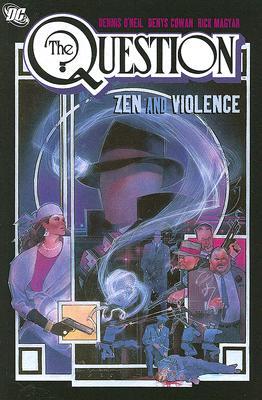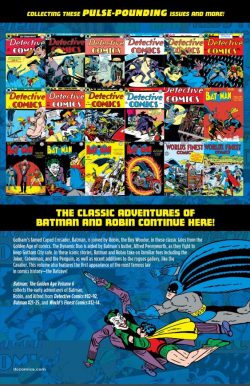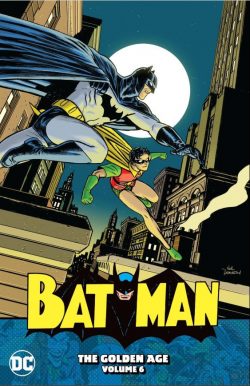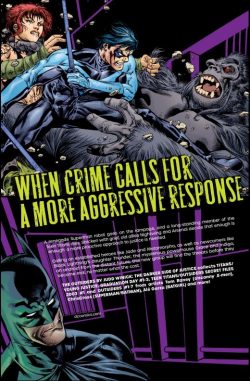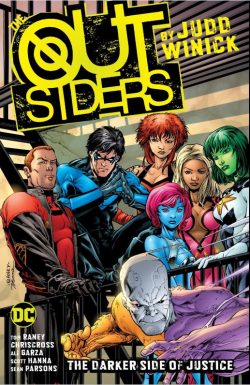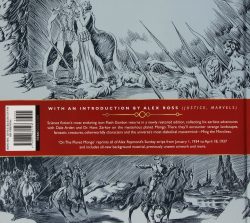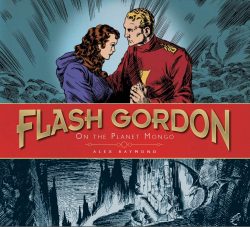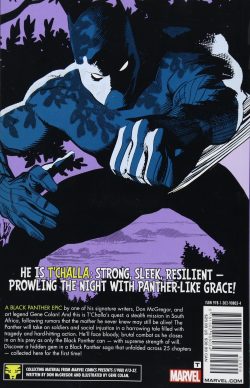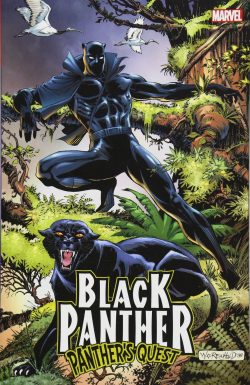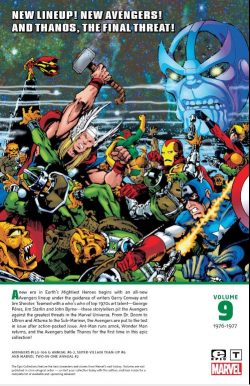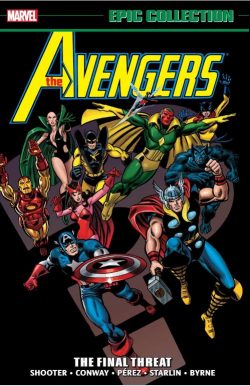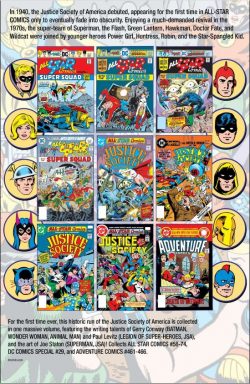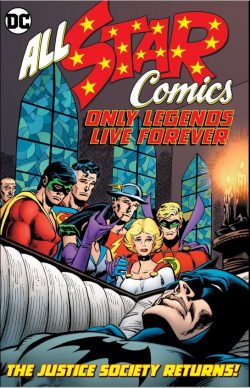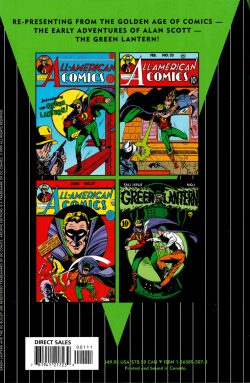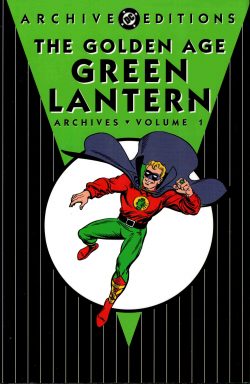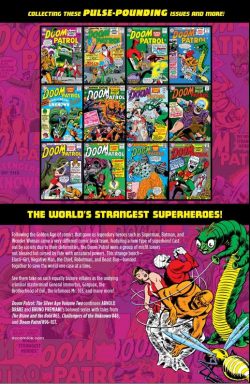
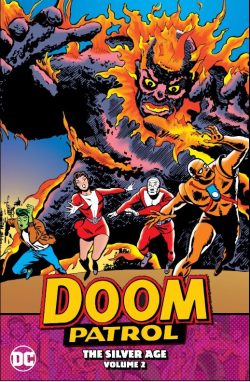
By Arnold Drake, Bob Haney, Bruno Premiani, Bob Brown, Dick Giordano & various (DC Comics)
ISBN: 978-1-7795-0098-4 (TPB)
1963 was the year when cautious comicbook publishers finally realised that superheroes were back in a big way and began reviving or creating a host of costumed characters to battle outrageous menaces and dastardly villains.
Thus it was that the powers-that-be at National Comics decided venerable anthology-mystery title My Greatest Adventure would dip its toe in the waters with a radical take on the fad. Still, famed for cautious publishing, they introduced a startling squad of champions with their thematic roots still firmly planted in the B-movie monster films of the era that informed the parent comic.
No traditional team of masked adventurers, this cast comprised a robot, a mummy and an occasional 50-foot woman, joining forces with and guided by a vivid, brusque, domineering, crippled mad scientist to fight injustice in a whole new way…
Covering June 1965 to November 1966, this stunning trade paperback – and eBook – compilation collects the Fabulous Freaks’ eccentric exploits from Doom Patrol #96-107, and includes a brace of team-ups: one from The Brave and the Bold #65 and an early crossover from Challengers of the Unknown #48.
The dramas were especially enhanced by the drawing skills of Italian cartoonist and classicist artist Giordano Bruno Premiani, whose highly detailed, subtly humanistic illustration made even the strangest situation dauntingly authentic and grittily believable. He was also the perfect vehicle to squeeze every nuance of comedy and pathos from the captivatingly involved and grimly light-hearted scripts by Arnold Drake who always proffered a tantalising believably world for the outcast heroes to strive in.
Premier tale ‘The Doom Patrol’ was co-scripted by Drake & Bob Haney, detailing how a mysterious wheelchair-bound scientist summoned three outcasts to his home through the promise of changing their miserable lives forever…
Competitive car racer Cliff Steele had died in a horrific pile up, but his undamaged brain had been transplanted into a fantastic mechanical body. Test pilot Larry Trainor had been trapped in an experimental stratospheric plane and become permanently radioactive, with the dubious benefit of gaining a semi-sentient energy avatar which could escape his body to perform incredible stunts for up to a minute at a time.
To pass safely amongst men Trainor had to constantly wrap himself in special radiation-proof bandages.
Ex-movie star Rita Farr had been exposed to mysterious swamp gases which gave her the terrifying, unpredictable and – at first – uncontrolled ability to shrink or grow to incredible sizes.
The outcasts were brought together by brilliant but enigmatic Renaissance Man the Chief, who sought to mould the solitary misfits into a force for good. He quickly proved his point when a mad bomber attempted to blow up the city docks. The surly savant directed the trio of strangers in defusing it and no sooner had the misfits realised their true worth than they were on their first mission…
…And they were off and running…
Now two years later Doom Patrol #96, opens on ‘The Day the World Went Mad!’, as frantic investigations reveal that a global wave of insanity is being caused by a deadly alliance of old foes The Brotherhood of Evil, alien tyrant Garguax and undying terrorist General Immortus. Cue last-ditch heroics …
In issue #97 that sinister syndicate attacks Earth by transforming innocent citizens into crystal, spectacularly resulting in ‘The War against the Mind Slaves’, heralding the return of super-rich wannabee and self-made superhero Mento, resulting in a stunning showdown free-for-all on the moon, after which #98 sees both ‘The Death of the Doom Patrol’ – a grievous over-exaggeration on behalf of transmutational foe Mr. 103 – who was actually compelled to save Caulder from radiation poisoning – and a Bob Brown-drawn solo-thriller ’60 Sinister Seconds’ in which Negative Man has to find and make safe four atomic bombs in different countries within one minute…
Brown also handled both tales in Doom Patrol #99, starting with an old-fashioned battle against a deranged entomologist whose mechanical insects deliver ‘The Deadly Sting of the Bug Man’ before proceeding to the groundbreaking first appearance of shape-shifting juvenile delinquent ‘The Beast-Boy’. He burgles then saves the team with his incredible ability to become any animal he could imagine…
An extended storyline began with #100 and ‘The Fantastic Origin of Beast-Boy’ (illustrated by Premiani) wherein the obnoxious kid is revealed as orphan Gar Logan: a child being slowly swindled out of his inheritance by his ruthless guardian Nicholas Galtry.
The conniving accountant even leases his emerald-hued charge to scientist Dr. Weir for assorted experiments, but when the Patrol later tackle rampaging dinosaurs, the trail leads unerringly to Gar who at last explains his uncanny powers…
Whilst in Africa as a toddler, Logan contracted a rare disease. His scientist father then tried an experimental cure which left him the colour of cabbage but with the ability to change shape at will. Now it appears that Weir has used the lad’s altered biology to unlock the secrets of evolution… or has he?
Despite foiling the scheme, the team have no choice but to return the boy to his guardian. However, Rita is not prepared to leave the matter unresolved…
The anniversary issue also saw the start of an extended multi-part thriller exploring Cliff’s early days after his accident and subsequent resurrection, beginning with ‘Robotman… Wanted Dead or Alive’.
Following Caulder’s implantation of Cliff’s brain into the mechanical body, the shock drove the patient crazy and Steele went on a city-wide rampage…
Doom Patrol #101 is riotous romp ‘I, Kranus, Robot Emperor!’, wherein an apparently alien mechanoid has a far more terrestrial and terrifying origin, but the real meat of the issue comes from the events of the subtle war between Galtry and the Chief for possession of Beast Boy.
The tale ends on a pensive cliffhanger as the Patrol then dashed off to rescue fellow adventurers The Challengers of the Unknown – but before that the second instalment of the Robotman saga sees the occasionally rational, if paranoid, Cliff Steele hunted by the authorities and befriended by crippled, homeless derelicts in ‘The Lonely Giant’…
Firmly established in the heroic pantheon, the Doom Patrol surprisingly teamed with fellow outsiders The Challengers of the Unknown at the end of 1965. The crossover began in the Challs’ title (specifically #48, cover-dated February/March 1966). Scripted by Drake and limned by Brown, ‘Twilight of the Challengers’ opened with the death-cheaters’ apparent corpses, and the DP desperately seeking who killed them…
Thanks to the Chief, our heroes recover and a furious coalition takes off after a cabal of bizarre super-villains. The drama explosively concluded in Doom Patrol #102, with ‘8 Against Eternity’ battling murderous shape-shifting maniac Multi-Man and his robotic allies to stop a horde of zombies from a lost world attacking humanity.
Another team-up follows as Haney, Dick Giordano & Sal Trapani craft ‘Alias Negative Man!’ for The Brave and the Bold #65 (May 1966), wherein Larry’s radio energy avatar is trapped by The Brotherhood of Evil and the Chief recruits The Flash to impersonate and replace him…
Doom Patrol #102 offered two tales, beginning with a tragedy that ensues when Professor Randolph Ormsby asks for the team’s aid in a space shot. When the doddery savant is transformed into a rampaging flaming monster dubbed ‘The Meteor Man’, it takes the entire team – as well as Beast Boy and Mento – to secure a happy outcome.
‘No Home for a Robot’, however, continues to reveal the Mechanical Marvel’s early days following Caulder’s implantation of Cliff’s brain into an artificial body. The shock had seemingly driven the patient crazy and Steele subsequently went on a city-wide rampage, continuously hunted and hounded by the police. Here the ferrous fugitive finds temporary respite with his brother Randy, but Cliff quickly realises trouble will trail him anywhere…
Issue #104 astounded everybody as Rita abruptly stops refusing the loathed Steve and becomes ‘The Bride of the Doom Patrol’. However, the guest star-stuffed wedding is almost spoiled when Garguax and the Brotherhood of Evil crash the party to murder the groom. So unhappy are Cliff and Larry with Rita’s “betrayalâ€, that they almost let them…
Even whilst indulging in her new bride status in issue #105, Rita can’t abandon the team, joining them to tackle old elemental enemy Mr. 103 during a ‘Honeymoon of Terror’, before back-up yarn ‘The Robot-Maker Must Die’ concludes the origin of Cliff Steele as the renegade attempts to kill the surgeon who had imprisoned him in a metal hell – which finally give Caulder a chance to fix the malfunction in Steele’s systems…
‘Blood Brothers’ in #106 introduces domestic disharmony as Rita steadfastly refuses to be a good trophy wife and resumes the hunt for Mr. 103 with the rest of the DP. Her separate lives continue to intersect, however, when Galtry hires the elemental assassin to wipe Gar and his freakish allies off the books.
The back-up section shifts focus onto ‘The Private World of Negative Man’: recapitulating Trainor’s doomed flight and the radioactive close encounter which turned him into a walking mummy. Tragically, even after being allowed to walk amongst men again, the gregarious pilot find himself utterly isolated and alone…
The Silver Age celebrations pause here with Doom Patrol #107 which begins an epic story-arc concerning ‘The War over Beast Boy’. Here Rita and Steve start legal proceedings to get Gar and his money away from Galtry, and the embezzler responds by opening a criminal campaign to beggar Dayton, inadvertently aligning himself with the Patrol’s greatest foes. Already distracted by the depredations of marauding automaton Ultimax, the hard-pressed heroes swiftly fall to the murderous mechanoid and Rita is dispatched to a barbaric sub-atomic universe…
The secret history of Negative Man continues and also ends on a cliffhanger with ‘The Race Against Dr. Death’. When fellow self-imposed outcast Dr. Drew tries to draw the pilot into a scheme to destroy the human species which had cruelly excluded them both, the ebony energy being demonstrates the incredible power it possesses to save the world from fiery doom.
To Be Continued…
Although as kids we all happily suspended disbelief and bought into the fanciful antics of the myriad masked heroes available, somehow the exploits of Doom Patrol – and their strangely synchronistic Marvel counterparts The X-Men (freaks and outcasts, wheelchair geniuses, both debuting in the summer of 1963) – always seemed just a bit more “real†than the usual cape-&-costume crowd.
With the edge of time and experience on my side it’s obvious just how incredibly mature and hardcore Drake, Haney & Premiani’s take on superheroes actually was. These superbly engaging, frantically fun and breathtakingly beautiful tales should rightfully rank amongst the finest Fights ‘n’ Tights tales ever told.
© 1965, 1966, 2020 DC Comics, Inc. All Rights Reserved.

